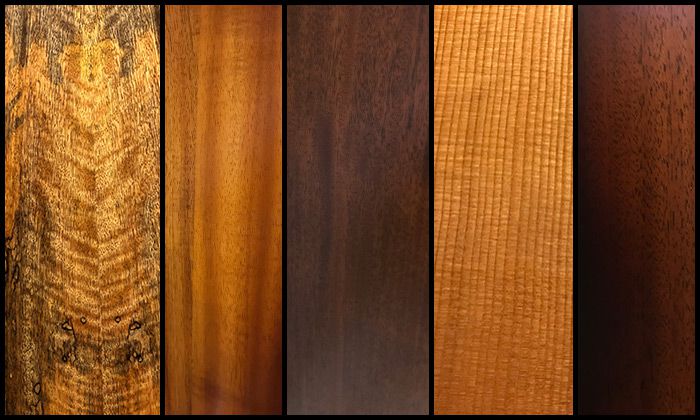Let’s be honest – wood looks good. The unique patterns and flames of a high-quality wood will always have great appeal. But I’m here today to tell you that wood serves an important purpose beyond making your axe look pretty. The species of wood each guitar is made from plays a huge role in the tonal quality of that guitar. So whether picking up your first guitar or adding yet another to your collection, knowing more about different guitar woods will help you pick the right instrument.
What are tone woods?

The woods selected for their unique tonal qualities are called “tone woods”. Different species of wood interact with sound vibrations in unique ways, imparting tonal characteristics like brightness, cleanness, earthiness or power, and accentuating treble or bass.
Laminated Wood vs Solid Wood
The pieces of wood used to build a guitar are thin, because they need to be able to flex into the desired shape. Laminated wood consists of even thinner layers glued (laminated) together into a single piece of appropriate thickness. This allows manufacturers to use a small amount of especially attractive wood as the finish and reinforce it with cheaper materials.
Solid wood guitars are made from, you guessed it, thin but solid pieces of wood. No layers, no lamination. The consistency of grain and thickness can produce better results than laminate guitars, but this style of guitar making comes with a larger price tag.
There are fair arguments for both styles of construction, and both styles have the potential to sound incredible. The only way to determine what is right for you is to give both styles a fair shake next time you visit your local store.
Which tone woods should you care about?
There are a lot of tone woods to choose from, and most guitars will use different combinations of tone woods to create the top, back, and sides. Here are the most important tone woods you need to know.
On Top

Spruce – Spruce is hands down the most common tone wood for guitar tops. You’ll recognize it by its pale yellow color, fine texture, and straight grains. Spruce offers a well-balanced sound that is both warm and bright. It also has fair volume and sustain, making it a good fit for a variety of situations.
Cedar – Cedar is another hugely popular wood for guitar tops, second only to spruce. Cedar is darker in color, tilting more toward a red-ish brown. Cedar creates a warmer sound than spruce, and offers subtlety and nuance perfect for fingerstyle guitarists. These features are thanks to the lighter density of the wood. The tradeoff is reduced volume, less brightness, and decreased sustain.
Mahogany – Though less common than cedar and spruce, mahogany still makes our top woods shortlist. As our friends at Taylor Guitars say “Mahogany is a good wood to anchor a discussion of tones, as a lot of other wood tones can be described in relation to it.” It’s a fantastic midrange tone wood, great for players who need a nice dynamic range and balanced tone.
Back & Sides

Mahogany – Mahogany is more than just a top wood. While a perfectly respectable top in its own right, mahogany also blends well with the other top woods we discussed, bringing its signature midrange power and dynamic range.
Rosewood – Both traditional and ever-popular, rosewood is iconic. Rosewood takes the solid midrange of mahogany and expands it up and down, offering a full low-end and sparkling treble. It delivers a versatile sound, lending itself to fingerpicking, flatpicking, and plain old strumming.
Koa – From the Big Island of Hawaii, Koa offers a solid midrange with added top end. Brand new, the Koa has a tight, top-heavy sound. However, as you play it, the wood will gradually open up, providing a pronounced midrange with greater resonance richness of tone. Not to mention it looks beautiful.
Walnut – Walnut’s density imparts a bright articulation in the treble range, with a warm tone and good sustain. Like Koa, walnut will gradually develop its mid and low ranges as it is played, offering and earthy depth.
The Takeaway
Tone woods are so much more than a fashion statement. They are the reason our guitars sound like they do, and as we learn more about them, we learn more about our own sound.
Hopefully you now have the information you need to do some very informed noodling next time you pick up a new guitar at your local music store. At the very least, we hope you have the lingo necessary to impress your friends.

